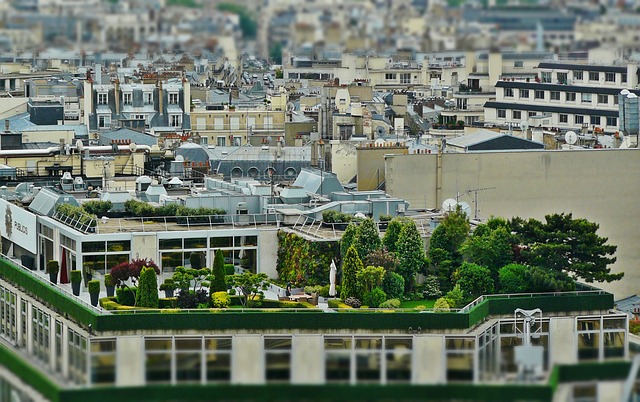Green roofs and rooftop gardens are emerging as sustainable urban solutions, offering both aesthetic appeal and ecological benefits. These living roofs enhance structural integrity, provide insulation, reduce energy consumption, and mitigate urban heat islands. Installation involves a structured assessment, preparation with drainage layers, waterproof membranes, and careful plant selection tailored to climate. Rooftop gardens improve water management, foster biodiversity, promote air quality, and create oases within urban spaces, making them valuable assets for eco-conscious cities. Sustainable roof systems like these contribute to overall building efficiency while integrating seamlessly with the environment.
Discover the transformative power of expert rooftop gardening! This comprehensive guide explores the world of green roofs and their profound environmental benefits. From understanding the fundamentals of living roofs to choosing the perfect design for your space, we delve into the installation process step-by-step, ensuring a sustainable roof system. Learn how these eco-friendly roof gardens not only enhance urban landscapes but also offer energy-saving solutions, making them an innovative choice for environmentally conscious folks.
- Understanding Green Roofs and Their Benefits
- Choosing the Right Design for Your Rooftop Garden
- The Installation Process: Step-by-Step Guide
- Maintaining a Sustainable Roof System
Understanding Green Roofs and Their Benefits
Green roofs, also known as living roofs or rooftop gardens, are gaining popularity as an eco-friendly and sustainable roofing solution in urban areas. This innovative concept involves planting a layer of vegetation on top of a building’s roof, creating a vibrant and functional space that offers numerous environmental benefits. A green roof is more than just a garden; it’s a sophisticated system designed to enhance the structural integrity of buildings while providing insulation, reducing energy consumption, and mitigating urban heat islands.
The installation of a sustainable roof system can significantly contribute to an building’s overall efficiency. By using native plants and deep-rooted vegetation, these roofs provide excellent water retention capabilities, helping to manage stormwater runoff and reduce the strain on municipal drainage systems. Furthermore, green roofing technology promotes biodiversity by creating habitats for local wildlife, including birds and insects. With proper maintenance, a rooftop garden can flourish, transforming urban landscapes into vibrant oases that offer both aesthetic appeal and environmental advantages.
Choosing the Right Design for Your Rooftop Garden
When designing a rooftop garden, it’s crucial to consider factors like space constraints, local climate, and your personal aesthetic preferences. A successful design should maximize the available area while incorporating elements that thrive in your region’s conditions. For instance, choose drought-resistant plants for arid climates or heavy-growing species suitable for wetter environments. Balancing functionality with aesthetics is key; a well-thought-out layout can transform your rooftop into an urban oasis, blending seamlessly with the surrounding environment.
The right design also leverages the latest green roofing technology to create sustainable roof systems. Living roofs, also known as green roofs, offer environmental roofing solutions that contribute to energy savings and enhanced insulation. These innovative setups incorporate a layer of vegetation, providing insulation during colder months and cooling effects in summer. By embracing eco-friendly roof gardens, homeowners not only elevate their outdoor spaces but also contribute to the overall health and sustainability of urban environments.
The Installation Process: Step-by-Step Guide
The Installation Process: A Step-by-Step Guide to Creating an Urban Green Roof
Transforming a traditional rooftop into a vibrant, eco-friendly sanctuary is a multifaceted process that requires careful planning and professional expertise. The journey begins with assessing your roof’s structural integrity to ensure it can support the additional weight of a green roof system. This step is crucial for selecting the appropriate design and materials, aligning with your structure’s unique demands. Once approved, the groundwork is laid, incorporating drainage layers and a waterproof membrane to safeguard against potential leaks.
Next, a layer of growing medium is carefully unfurled, providing the perfect environment for a plethora of plants and vegetation. This step involves selecting native species or drought-resistant varieties, depending on your climate and water management considerations. The garden’s framework is then constructed, using materials like metal or plastic grating to support the plants while allowing excess water to pass through. Finally, the actual planting occurs, where a diverse array of flora is incorporated into the roof’s design, enhancing its aesthetics and contributing to a sustainable urban environment.
Maintaining a Sustainable Roof System
A sustainable roof system goes beyond mere aesthetics; it’s an integral part of creating an eco-friendly environment. Rooftop gardens, also known as green or living roofs, are innovative solutions that transform traditional rooftops into vibrant ecosystems. These gardens offer a range of environmental benefits, including improved insulation, reduced urban heat islands, and enhanced water management. By integrating plants and soil into the roofing structure, these spaces create an insulating layer that minimizes temperature fluctuations, thereby reducing energy consumption for heating and cooling.
The installation of green roofs involves advanced technology and careful planning. It includes structuring the roof to support the additional weight, selecting suitable plant species adapted to the local climate, and implementing efficient irrigation systems. Modern green roofing solutions prioritize water conservation by harnessing rainwater, which can be used for garden irrigation or even redirected to alleviate urban flooding. This sustainable approach not only contributes to a greener urban environment but also provides spaces that promote biodiversity, improve air quality, and offer serene retreats in bustling cities.
A well-designed and expertly installed rooftop garden offers a unique opportunity to transform urban spaces into vibrant oases that provide numerous environmental benefits. By integrating green roofing technology, such as living roofs and sustainable roof systems, cities can embrace nature while also reaping energy-saving advantages. With the right choice of design and proper maintenance, these eco-friendly roof gardens contribute to a healthier planet by mitigating the urban heat island effect and improving air quality. So, whether you’re considering an urban green roof or an expansive eco-friendly roof garden, professional installation ensures a beautiful, functional, and sustainable result.
